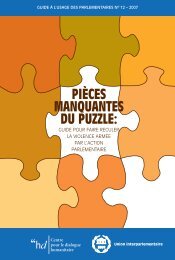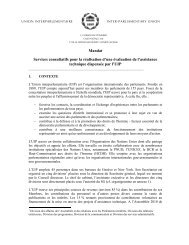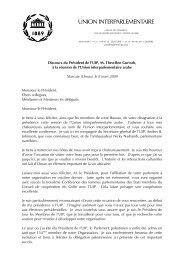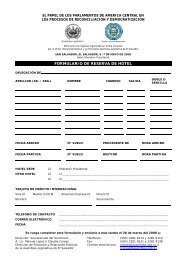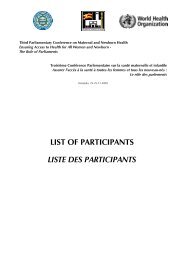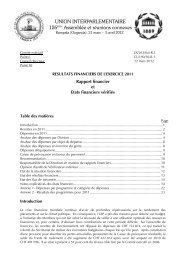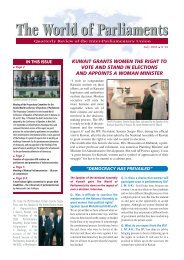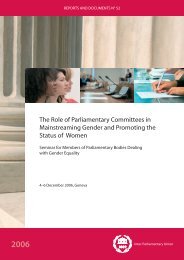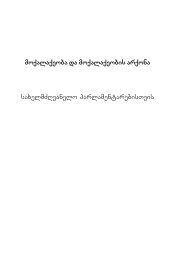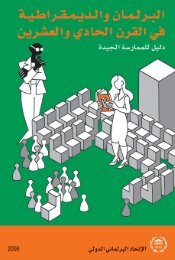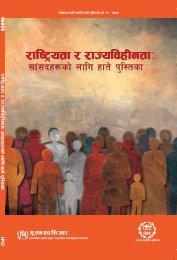MISSING PIECES - Inter-Parliamentary Union
MISSING PIECES - Inter-Parliamentary Union
MISSING PIECES - Inter-Parliamentary Union
You also want an ePaper? Increase the reach of your titles
YUMPU automatically turns print PDFs into web optimized ePapers that Google loves.
<strong>MISSING</strong> <strong>PIECES</strong><br />
In December 2003, the Wassenaar Arrangement also agreed to Elements<br />
for Export Controls of MANPADS, which calls on members to restrict<br />
exports of man-portable air defence systems (MANPADS) only to governments<br />
or their authorised agents and to take into account other factors,<br />
including the potential for misuse in the recipient country. 12 (See Annex 5<br />
for more instruments of relevance to small arms transfers)<br />
BOX 6 LEGAL CHALLENGES FOR RESTRICTING ARMS TRANSFERS<br />
The Draft Framework Convention on <strong>Inter</strong>national Arms Transfers (also known<br />
as the Arms Trade Treaty or ATT) has gathered growing international attention<br />
since 2003. 13 Since then, over one million people have signed up in support<br />
of its principles, and in December 2006 some 153 governments aligned themselves<br />
to moving forward on such an initiative through the adoption of a<br />
General Assembly resolution calling for an examination of the feasibility of<br />
an arms trade treaty. 14 However, some important issues will need to be<br />
clarified in the coming months:<br />
1. Clarifying the international legal basis for rules prohibiting transfers<br />
As it currently stands, the ATT proposal attempts to codify existing international<br />
law with reference to the obligation of states under the law of state<br />
responsibility. This law prohibits states from aiding and assisting other states<br />
in the commission of an internationally wrongful act, which can include<br />
serious breaches of IHL or human rights law. What happens, however, when<br />
weapons are transferred to non-state armed groups that are not directly<br />
covered under the concept of state responsibility?<br />
The emerging international criminal law notion of ‘complicity’ might<br />
assist, as it encompasses the positive obligation of state officials to investigate<br />
the end-use of the weapons they transfer, as they may incur responsibility<br />
for making violations possible by providing material assistance to the perpetrators.<br />
Rules against complicity are intended to ensure states do not<br />
become accomplices in the violent behaviour of others, whether other states,<br />
armed groups, corporations, or individuals.<br />
In addition, there are clear positive obligations on states to ensure<br />
respect for IHL, and this is widely accepted as including obligations towards<br />
preventing or punishing breaches of IHL abroad. There is also a developing<br />
notion that states must co-operate in the protection and fulfilment of human<br />
rights beyond their borders. In both cases, these rules provide support for<br />
strict criteria to prohibit transfer where the guns are likely to be used to<br />
commit human rights or humanitarian law abuses.<br />
2. Clarifying the precise criteria of prohibition<br />
Existing proposals list very general criteria, such as ‘violations of human<br />
rights’. It is likely that when states sit down to negotiate criteria for arms<br />
transfers, there will need to be a good deal of discussion to give more precision<br />
to these general phrases. For both human rights and humanitarian<br />
law criteria, there is a firm basis in existing international standards to list<br />
46



